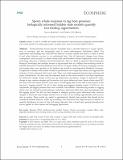Sperm whale response to tag boat presence : biologically informed hidden state models quantify lost feeding opportunities
Abstract
Animal-attached sensors provide invaluable data to describe behavior of cryptic species, such as cetaceans, and are increasingly used to assess anthropogenic disturbance effects. Tag deployment and handling may itself alter the behavior of study animals and there is a need to assess if and when behavior recovers to an undisturbed level. Not all behavioral changes have fitness consequences, and our goal is to derive metrics that can be linked to fitness implications, such as time and energy allocation to different functional behaviors. Here we detail an approach that incorporates biological knowledge and multiple streams of tag-recorded data in a hidden state-switching model to estimate time series of functional behavioral st ates for 12 sperm whales off Norway. Foraging, recovery and resting states were specified in the hidden state model by state-dependent likelihood structures. Comparison of hidden state models revealed a parsimonious set of input time series, and supported the inclusion of a less informed 'silent active' state. There was a high agreement between state estimates and expert classifications. We then used the estimated states in time series models to test three hypotheses for behavioral change during suction-cup tag deployment procedures: change in behavioral states, change in prey capture attempts and locomotion cost, given behavioral state. Sperm whales spent 34% less time at the sea surface and 60% more time in non-foraging silent active state in the presence of the tag boat (''tagging period'' 0.1-2.8 h) than during post-tagging baseline period (1.8-20.8 h). No comparable pre-tagging baseline data were available. Nevertheless, time-decaying models of tagging effects were not retained in model selection, indicating a short-term effect that ceased immediately after the tagging period. We did not find changes in energetic proxies, given behavioral state, however changes in functional state budget indicate costs in terms of lost feeding opportunities and recovery time at surface. These results are useful to quantitatively identify data periods that should not be considered baseline behavior within tag recordings. This functional state approach proves effective to quantify disturbance in terms of time and energy allocation that is based upon general principles that can be applied to other species and biologging applications.
Citation
Isojunno , S & Miller , P J O 2015 , ' Sperm whale response to tag boat presence : biologically informed hidden state models quantify lost feeding opportunities ' , Ecosphere , vol. 6 , no. 1 . https://doi.org/10.1890/ES14-00130.1
Publication
Ecosphere
Status
Peer reviewed
ISSN
2150-8925Type
Journal article
Description
The authors acknowledge the UK Ministry of Defence, U.S. Office of Naval Research, and World Wildlife Fund (Norway) for funding this research.Collections
Items in the St Andrews Research Repository are protected by copyright, with all rights reserved, unless otherwise indicated.

